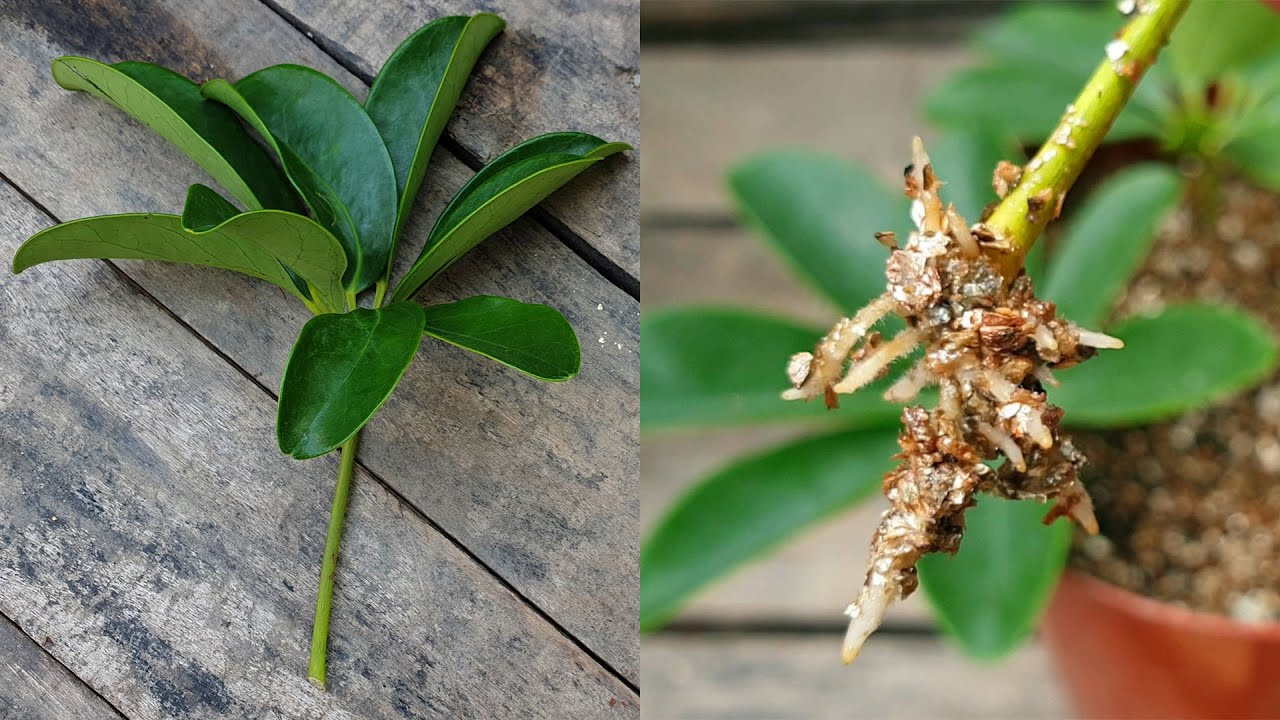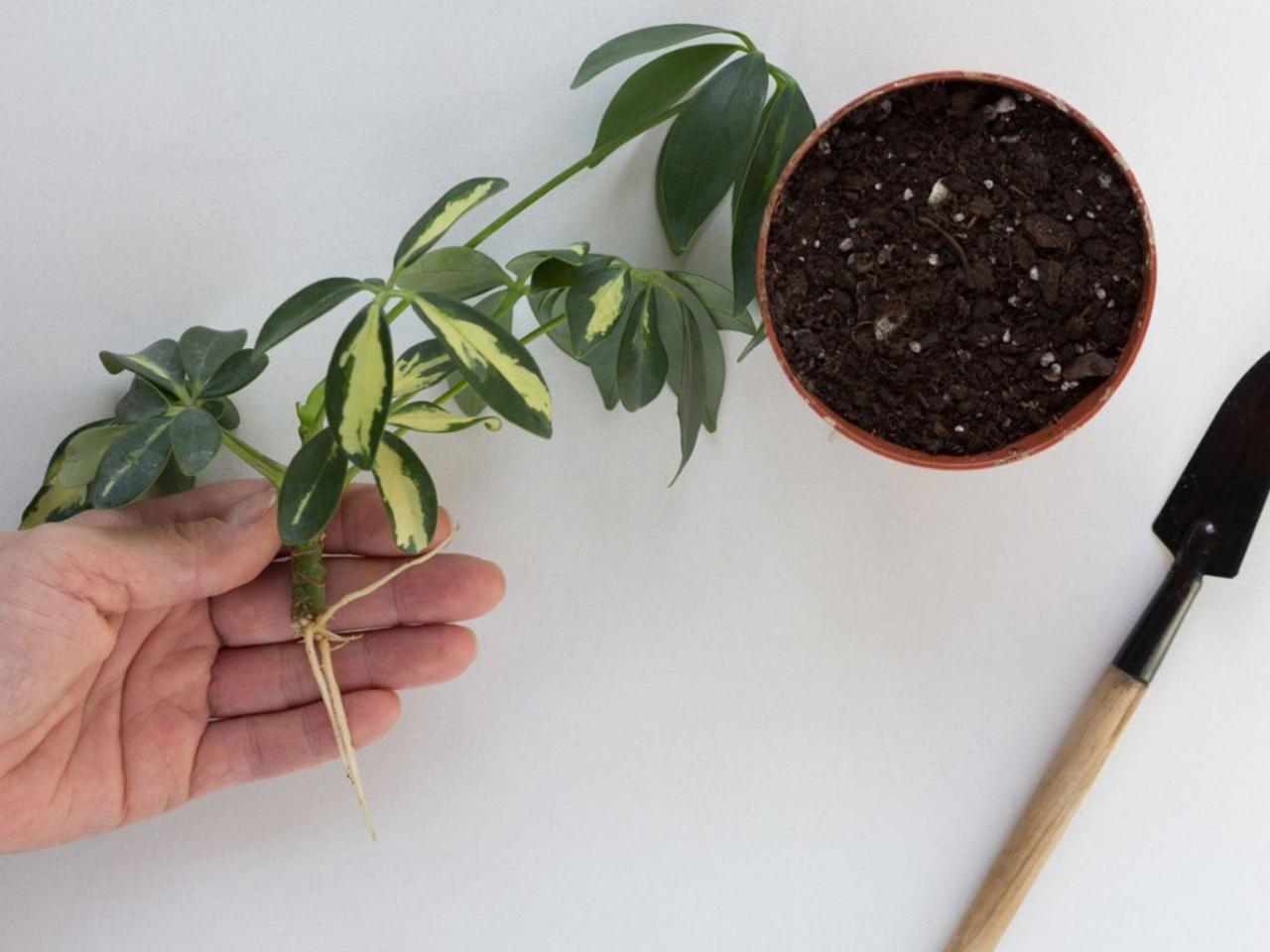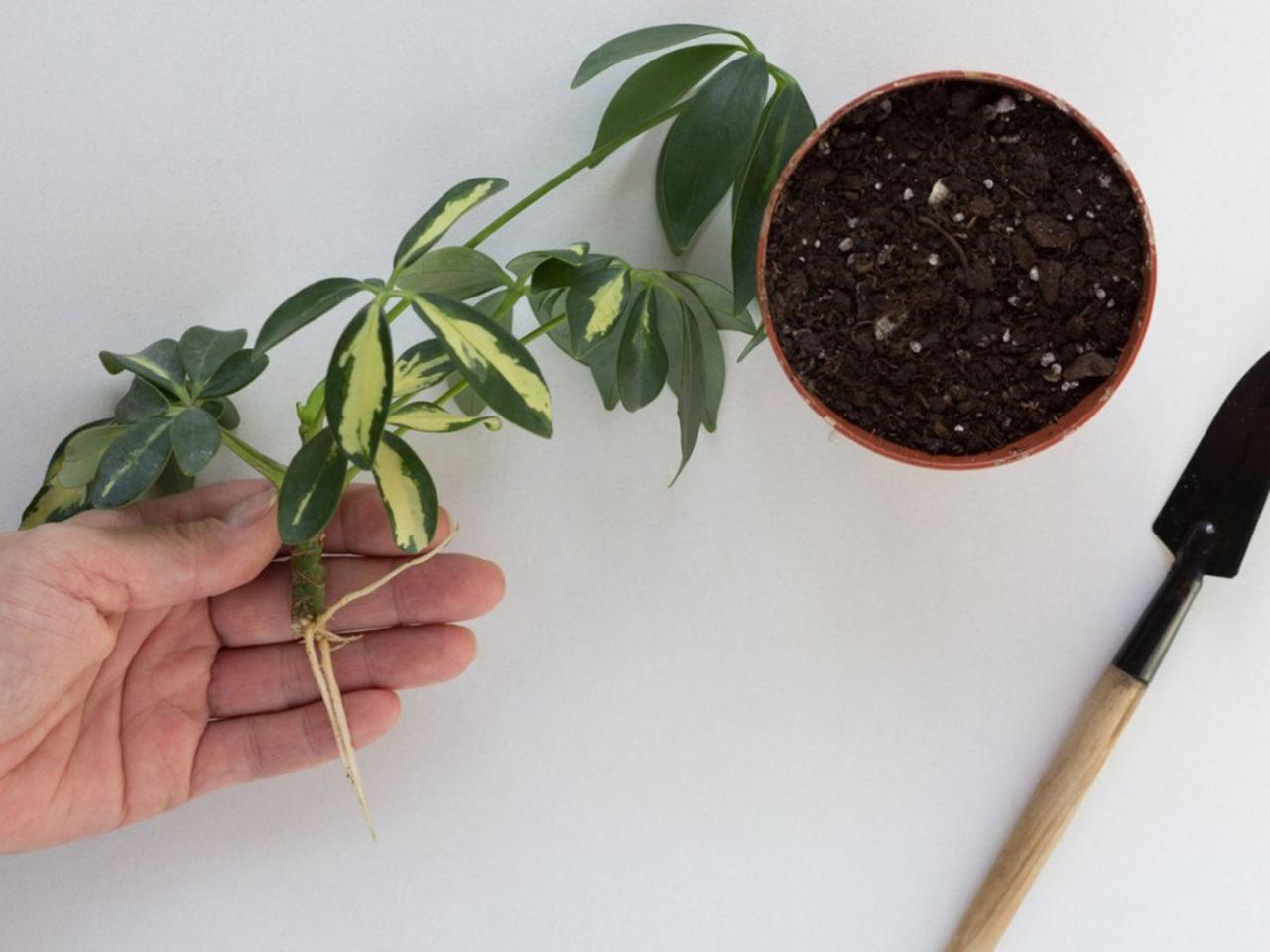How to Grow a Flourishing Schefflera Collection with Effective Propagation is a guide for plant enthusiasts eager to expand their green spaces with these versatile and captivating plants. Scheffleras, often referred to as umbrella trees, are known for their elegant, feathery foliage and adaptability, making them a popular choice for both indoor and outdoor environments.
With their unique charm and relatively easy care requirements, Scheffleras are a rewarding addition to any plant collection.
This comprehensive guide delves into the intricacies of Schefflera propagation, exploring various methods and providing step-by-step instructions for successful rooting. We’ll cover the essential aspects of cultivating a thriving Schefflera collection, including optimal growing conditions, proper care techniques, and creative display ideas.
By following these tips and techniques, you can nurture a flourishing collection of Scheffleras that will bring a touch of tropical elegance to your home or garden.
Introduction to Schefflera

Schefflera, commonly known as the umbrella tree or the dwarf umbrella tree, is a popular and versatile genus of flowering plants native to tropical and subtropical regions around the world. Their unique and striking foliage, coupled with their adaptability to various indoor and outdoor conditions, has made them a beloved choice among home gardeners and plant enthusiasts.Schefflera plants are known for their attractive, palmate leaves, which resemble an open umbrella.
These leaves are typically composed of several leaflets, ranging from 5 to 16, depending on the species and variety. Their vibrant green foliage provides a refreshing and lush aesthetic to any space, making them an excellent choice for adding a touch of nature to homes, offices, and gardens.
Varieties of Schefflera
Schefflera encompasses a diverse range of species and cultivars, each offering its own unique characteristics and appeal. Here are some of the most popular varieties:
- Schefflera actinophylla (Australian Umbrella Tree):This species is renowned for its large, deeply lobed leaves, which can reach up to 2 feet in diameter. It is a robust and fast-growing plant that thrives in bright, indirect light and prefers moist, well-drained soil.
- Schefflera arboricola (Dwarf Umbrella Tree):As its name suggests, this variety is more compact than the Australian Umbrella Tree, with smaller leaves and a more compact growth habit. It is commonly grown as a houseplant and is known for its tolerance to low light conditions.
- Schefflera elegantissima (Amate):This variety is highly prized for its striking foliage, which features long, slender, and pointed leaflets with a distinctive variegated pattern of cream and green. It is a relatively slow-growing plant that requires bright, indirect light and consistent humidity.
- Schefflera venulosa (Laceleaf Schefflera):This variety is known for its delicate, lace-like foliage, which features finely divided leaflets with a velvety texture. It is a popular choice for hanging baskets and prefers moderate to bright, indirect light.
Reasons for Popularity
Schefflera plants are a popular choice for several reasons:
- Easy Care:Schefflera are relatively low-maintenance plants that are tolerant of a wide range of conditions, making them suitable for both experienced and novice gardeners.
- Air Purifying:Studies have shown that Schefflera plants can effectively remove certain pollutants from the air, contributing to a healthier indoor environment.
- Versatility:Schefflera plants can be grown in various settings, including homes, offices, patios, and gardens. They can be cultivated as potted plants, hanging baskets, or even as small trees.
- Attractive Foliage:Their striking, palmate leaves add a touch of elegance and sophistication to any space, making them a popular choice for both indoor and outdoor decoration.
The Importance of Propagation
Propagation is a crucial aspect of cultivating Schefflera plants, offering several benefits to enthusiasts. By learning and implementing effective propagation techniques, you can significantly expand your Schefflera collection while minimizing costs.
Growing a flourishing Schefflera collection through propagation requires patience and understanding of the plant’s needs. While you’re cultivating your own indoor jungle, don’t forget to visit the great outdoors for inspiration! The Top Attractions at Harvest Moon Orchard This Season offers a glimpse into the wonders of nature, reminding us of the beauty and diversity found in both cultivated and wild plant life.
Returning to your Schefflera propagation, remember to provide consistent moisture and indirect sunlight, and you’ll be rewarded with a thriving collection of these beautiful houseplants.
Methods of Propagation
There are various methods for propagating Schefflera plants, each with its own set of advantages and disadvantages. The most common methods include stem cuttings, air layering, and seed propagation.
- Stem Cuttings: This method involves taking cuttings from the stems of healthy Schefflera plants and rooting them in a suitable medium. Stem cuttings are generally the most common and effective method for propagating Schefflera plants. They are relatively easy to take and root, and they produce new plants that are genetically identical to the parent plant.
- Air Layering: Air layering involves inducing root growth on a stem while it is still attached to the parent plant. This method is particularly useful for propagating Schefflera plants that are difficult to root from cuttings, such as those with thick stems.
- Seed Propagation: Seed propagation involves planting Schefflera seeds to grow new plants. While this method is less common than stem cuttings or air layering, it can be a viable option for obtaining a large number of plants.
Comparison of Propagation Methods
Method |
Effectiveness |
Suitability |
|---|---|---|
Stem Cuttings |
Highly effective |
Suitable for most Schefflera varieties |
Air Layering |
Moderately effective |
Best for plants with thick stems or those difficult to root from cuttings |
Seed Propagation |
Less effective |
Suitable for obtaining a large number of plants, but may not produce plants identical to the parent |
Step-by-Step Guide to Propagating Schefflera: How To Grow A Flourishing Schefflera Collection With Effective Propagation
Propagating Schefflera plants through stem cuttings is a rewarding and straightforward process that allows you to expand your collection while enjoying the satisfaction of nurturing new life. This method is particularly effective for Schefflera, as it readily produces roots from stem cuttings.
Preparing the Cuttings
Before taking cuttings, it’s essential to select healthy, disease-free stems from your parent Schefflera plant. Ideally, choose stems that are at least 6 inches long and have multiple nodes (the points where leaves emerge).
- Using sharp, clean pruning shears or a knife, make a clean cut just below a node, ensuring a sharp angle to promote root growth.
- Remove any leaves that will be submerged in the rooting medium. This prevents rot and allows the cutting to focus its energy on root development.
- Optional: Dip the cut end of the stem in rooting hormone powder. This promotes root growth and enhances the success rate of propagation.
Rooting Medium
The choice of rooting medium is crucial for providing the right environment for root development. Several options are suitable for Schefflera propagation.
- Perlite:This lightweight, porous material provides excellent drainage and aeration, crucial for preventing root rot.
- Vermiculite:Similar to perlite, vermiculite offers good drainage and moisture retention, creating a favorable rooting environment.
- Coco Coir:A natural and sustainable option, coco coir retains moisture and provides essential nutrients for root development.
- Seed Starting Mix:This readily available mix is formulated for seed germination and offers good drainage and moisture retention, making it suitable for Schefflera cuttings.
Rooting Environment
Creating the right rooting environment is essential for promoting root growth and ensuring successful propagation.
- Humidity:Schefflera cuttings thrive in high humidity. To achieve this, you can use a propagation dome or cover the pot with a plastic bag. This helps to retain moisture and create a warm, humid environment.
- Temperature:Warm temperatures are ideal for root development. Aim for a temperature range of 70-75°F (21-24°C). You can achieve this by placing the cuttings in a warm location or using a heating mat.
- Light:Schefflera cuttings need bright, indirect light. Avoid direct sunlight, which can scorch the leaves and hinder root development. A south-facing window with a sheer curtain is a good option.
Ensuring Successful Rooting
Maintaining consistent humidity, temperature, and light levels is crucial for successful rooting.
- Watering:Keep the rooting medium consistently moist, but not waterlogged. Allow the top inch of the medium to dry slightly between waterings. Overwatering can lead to root rot.
- Ventilation:Ensure good ventilation to prevent fungal growth. Remove the propagation dome or plastic bag for a few hours each day to allow for air circulation.
- Patience:Schefflera cuttings can take several weeks to develop roots. Be patient and don’t disturb the cuttings too often. Check for root development by gently tugging on the cutting. If it offers resistance, it’s likely that roots have formed.
Cultivating a Flourishing Schefflera Collection

Creating a thriving Schefflera collection requires understanding and providing the ideal growing conditions for these versatile plants. From light and temperature preferences to suitable potting mixes and fertilization techniques, mastering these elements will ensure your Schefflera plants flourish and thrive.
Optimal Growing Conditions for Schefflera
Providing the right environment is crucial for healthy Schefflera growth. Schefflera plants are adaptable but thrive in specific conditions.
- Light:Schefflera prefer bright, indirect light. Direct sunlight can scorch their leaves, so it’s best to place them near a window with filtered sunlight or in a location with bright, indirect light.
- Temperature:Schefflera thrive in moderate temperatures, between 65°F and 75°F (18°C and 24°C). They can tolerate slightly cooler temperatures but prefer to avoid drafts and cold temperatures.
- Humidity:Schefflera prefer moderate to high humidity. In dry environments, you can increase humidity by misting the leaves regularly, placing the plant on a pebble tray filled with water, or using a humidifier.
- Watering:Water Schefflera thoroughly when the top inch of soil feels dry to the touch. Allow the excess water to drain out, and avoid letting the plant sit in water. During the winter months, reduce watering frequency as the plant’s growth slows down.
Potting Mix and Fertilizer Recommendations
Choosing the right potting mix and fertilizer is essential for providing Schefflera plants with the nutrients they need for healthy growth.
- Potting Mix:Schefflera thrive in well-draining potting mixes that are slightly acidic to neutral (pH 6.0 to 7.0). A good potting mix for Schefflera consists of a blend of peat moss, perlite, and vermiculite. Avoid using heavy clay-based potting mixes that can retain too much water and lead to root rot.
- Fertilizer:Fertilize Schefflera plants during the growing season (spring and summer) with a balanced liquid fertilizer diluted to half strength. Avoid over-fertilizing, as this can lead to leaf burn. During the winter months, reduce or stop fertilization as the plant’s growth slows down.
Maintaining the Health and Vitality of Your Schefflera Collection, How to Grow a Flourishing Schefflera Collection with Effective Propagation
Regular maintenance practices ensure the long-term health and vitality of your Schefflera collection.
- Pruning:Pruning Schefflera plants helps maintain their shape and encourages bushier growth. Pinch off the growing tips of stems to promote branching. Remove any dead, diseased, or damaged leaves and stems.
- Repotting:Repot Schefflera plants every two to three years or when the roots become pot-bound. Use a slightly larger pot and fresh potting mix.
- Pest Control:Schefflera plants are generally pest-resistant but can be susceptible to spider mites, mealybugs, and aphids. Regularly inspect your plants for signs of pests and treat them promptly with an appropriate insecticide.
Designing a Stunning Schefflera Display
A well-cultivated Schefflera collection is a testament to your horticultural skills and a source of pride. However, it’s not just about growing them; it’s about showcasing their beauty. Designing a stunning Schefflera display involves creative container choices, strategic arrangement, and thoughtful pairings with complementary plants.
Expanding your Schefflera collection through propagation is a rewarding endeavor. While Scheffleras are known for their resilience, understanding the nuances of propagation techniques can significantly boost your success rate. Much like the meticulous approach needed for Propagating Venus Fly Traps: Tips and Tricks You Need to Know , careful attention to factors like humidity and rooting medium is crucial for Schefflera propagation.
By mastering these techniques, you’ll be well on your way to a flourishing Schefflera collection.
Container Options and Arrangement Styles
The right container can elevate your Schefflera’s visual appeal. Here are some ideas:
- Terracotta Pots:Classic and elegant, terracotta pots provide a rustic charm and allow for good drainage. You can choose from various sizes and shapes to create visual interest.
- Ceramic Pots:Ceramic pots come in a vast array of colors, patterns, and finishes, allowing you to personalize your display. Glossy or matte finishes can create different moods.
- Hanging Baskets:Ideal for showcasing cascading Schefflera varieties, hanging baskets add verticality and create a lush, airy feel.
- Modern Planters:Sleek, minimalist planters made from materials like metal, concrete, or wood provide a contemporary touch and complement modern interiors.
When arranging your Schefflera collection, consider these styles:
- Symmetrical Arrangement:Create a sense of balance and formality by arranging Schefflera plants in a symmetrical pattern, using similar containers and sizes.
- Asymmetrical Arrangement:Break the symmetry and create a more dynamic display by using varying container sizes and heights, placing plants at different angles.
- Grouping by Variety:Gather Schefflera plants of the same variety together to create a cohesive look. For example, a grouping of ‘Amate’ Schefflera with their deeply lobed leaves will create a dramatic statement.
- Mixed Variety Display:Combine different Schefflera varieties for a diverse and visually interesting display. Consider contrasting leaf shapes and textures for added depth.
Combining Schefflera with Other Houseplants
Schefflera plants are versatile and can be combined with various houseplants to create stunning displays. Here are some complementary pairings:
- Tropical Companions:Pair Schefflera with other tropical plants like ferns, philodendrons, or anthuriums to create a lush, jungle-like atmosphere.
- Textural Contrast:Combine Schefflera with plants that offer contrasting textures, such as succulents, cacti, or grasses, to create visual interest and depth.
- Color Play:Use Schefflera’s green foliage as a backdrop for flowering plants with vibrant colors, like African violets, bromeliads, or orchids.
Schefflera Varieties and Ideal Display Locations
Here is a table outlining different Schefflera varieties and their ideal display locations within a home:
Variety |
Ideal Display Location |
|---|---|
Schefflera arboricola ‘Amate’ |
Living room, bedroom, office, or entryway |
Schefflera actinophylla (Umbrella Tree) |
Sunroom, conservatory, or large living space |
Schefflera arboricola ‘Gold Capella’ |
Brightly lit room, kitchen, or bathroom |
Schefflera arboricola ‘Variegata’ |
Brightly lit room, entryway, or hallway |
Outcome Summary
With a little knowledge and dedication, you can embark on a rewarding journey of growing a flourishing Schefflera collection. By mastering the art of propagation, providing the right care, and unleashing your creativity in display arrangements, you can transform your home or garden into a verdant oasis filled with the captivating beauty of Schefflera plants.
Whether you’re a seasoned plant enthusiast or just starting your green thumb journey, the world of Schefflera awaits, promising a fulfilling experience of growth and horticultural artistry.
FAQ Overview
What is the best time of year to propagate Schefflera?
The ideal time to propagate Schefflera is during the spring and summer months when the plant is actively growing and has more energy for rooting.
How long does it take for Schefflera cuttings to root?
It typically takes around 4-6 weeks for Schefflera cuttings to develop a strong root system. However, rooting time can vary depending on factors like the propagation method, rooting environment, and the specific variety of Schefflera.
Can I propagate Schefflera from seeds?
While Schefflera can be propagated from seeds, it is a less common method as it can be more time-consuming and less predictable compared to cuttings or air layering.
